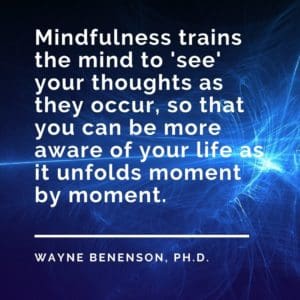When my kids were preschoolers, I remember seeing the movie “Blade Runner.” Or, more precisely, I remember not seeing it. After the initial viewing, I had almost no recall about it. There are many plotlines in this sci-fi cult classic. However, they were totally lost on me because I was lost in thought. Big time. I was stuck on autopilot, ruminating, no doubt, on my problems du jour. Although my body was present in the theater that night, my mind was somewhere else.
Do you have a similar tale to tell? Maybe it’s your daily commute to work where you don’t really see the landscape. Maybe it’s a conversation with your spouse to which you cannot identify a single word afterward.

Autopilot is like waking up from a dream. We suddenly realize we’ve been gone for minutes, maybe even hours. About a decade after its first release, I saw “Blade Runner” again. This time I really paid attention. During the second go around, I mixed bits and pieces from my swiss-cheese memory file of the film with what was really lost the first time around – the emotional content of the story, its conflict and paradox and mystery. I had totally blanked out on the story (a good one at that). This surprised me. I wondered how often I blanked out on the emotional content of other events in my life.
Neuroscience can actually answer that question. Dr. Amishi Jha, who studies the durability of attention on U.S. Army soldiers, estimates that we are missing 50% of our life. Her research has revealed how mindfulness training can protect and strengthen attention. She has developed a very simple three-step attention practice called “push-ups for your mind”: Focus, Notice and Redirect.
Focus, Notice and Redirect
- Focus means to direct your attention on breath-related sensations, such as your tummy moving up and down or the quality of air moving in your nostrils. (Try this real fast: is the air entering your nostrils on the inhale cool or warm? Is the air of the exhale cool or warm?)
- Notice means to redirect your mind back to the breath when it has wandered. This is especially important with very familiar tasks. Check out this case in point. A social experiment was conducted by the Washington Post. A man with a violin played Bach for 45 minutes at a metro stop. During that period of time approximately 2,000 people went through the station, most of them on their way to work. Only 6 people stopped and listened for a while. Unbeknownst to these commuters was that the man who played the violin was the renowned classical musician Joshua Bell who played a very challenging piece on a violin worth $3.5 million. The mindless habit of being lost in thought for the vast majority of those commuters meant missing out on whatever was right in front of them. So when you get distracted gently return to the breath cycle to short-circuit unconscious amnesia. The act of simply noticing when your thoughts, sensations or memories shift can bring back your body and mind to the present moment.
- Redirect: Mindfulness can bring you back, again and again, to full conscious awareness. That’s what it means to redirect. You just redirect your attention back to the breath. It’s an opportunity to “check in” with yourself so you can make intentional choices. When you become more mindful, you bring your intentions and actions back into alignment rather than being sidetracked by a mind on autopilot. You learn to stop wasting time pointlessly running through subconscious “distracted” habits of thinking or doing what no longer serves any useful purpose.

That’s the drill. Simply return back to the breath as many times as you need to. This mindful, or “being” mode allows you to become fully conscious of your life again. You can more clearly observe what’s happening in the here and now when you shift and see thoughts as mental events rather than something solid and real. Thoughts are valuable but they are not “you” or “reality.” They are your internal running commentary on yourself and the world. Mindfulness trains the mind to “see” your thoughts as they occur, so that you can be more aware of your life as it unfolds moment by moment.
Calming the mind also helps the brain become more efficient with something neuroscientists call body budgeting. Strengthening your mental attention muscles helps you manage your body’s resource budget, i.e., how much you spend or deposit for an optimal body response. How? When you are hungry, you can open the fridge. When you are tired, you can go to bed. When you are cold, you can put on a coat. And when you are agitated or distracted, you can take deep breaths to calm your nerves. What a great way to reduce the 50% of your life you are on autopilot.
Homework: Answer the following question from three different time frames: Am I fully engaged in whatever is happening in the present moment? First, recall three things that have happened in your life during the past 24 hours. Then, recall three events that happened this morning. Finally, recall another three that have happened in the few minutes since you began reading this article. How has your attention changed during each time chunk? As always, enjoy the moment.
Dr. B, aka Wayne Benenson, Ph.D., has had lots of career opportunities to be mindful: as an elementary and early childhood teacher, a college professor and a researcher on peer mediation. He currently offers mindfulness tutorials, short and sweet (20 minutes), via Zoom. For more information check out his Facebook page at or contact him here.



